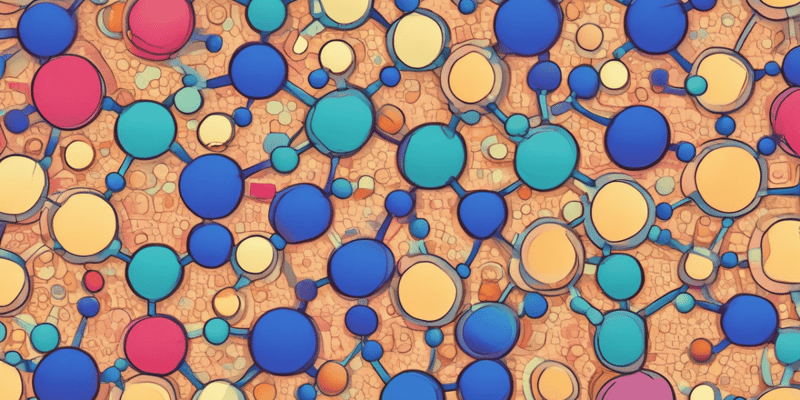24 Questions
What is a characteristic of biological lipids?
They are insoluble in water.
What is the main component of lipids?
Alcohol and fatty acids
What is a function of triacylglycerols?
Energy storage
What is a function of phospholipids?
Structural elements of the cell membrane
What is the combination of lipids and proteins called?
Lipoprotein
What type of lipids are phospholipids and glycolipids?
Complex lipids
What is a function of bile acids?
Emulsification
What is a classification of lipids?
Simple and complex lipids
What is the functional role of fatty acids in the body?
They are involved in the synthesis of complex lipids and can be oxidized to produce energy
What is the general characteristic of the hydrocarbon chain of fatty acids found in natural oils?
They have an even number of carbon atoms and are in straight chain form
How do fatty acids differ from each other?
By both the carbon chain length and the number and location of double bonds
What is the suffix added to the end of the hydrocarbon chain name to form the name of a fatty acid?
-oic
What is the notation used to indicate the location of a double bond in a fatty acid?
Δ symbol with the number of the carbon atom
What is the characteristic of the majority of fatty acids found in nature?
They have 16 and 18 carbon atoms
What is the range of chain lengths of fatty acids found in higher plants and animals?
14 to 22
Which of the following fatty acids is unsaturated?
C18:1 Oleic acid
What is the term used to describe the property of fatty acids that allows them to dissolve in both water and oil?
Amphipathic
What is the effect of increasing chain length on the melting points of fatty acids?
It increases the melting points
In which state are fatty acids found in significant amounts in plasma?
Fasting state
What is the reason why mammals cannot synthesize fatty acids with more than one double bond?
They lack enzymes to form double bonds at the C atoms after carbon number 9
Why are linoleic and linolenic acids considered essential fatty acids?
They cannot be synthesized in mammals and must be taken from the diet
What is the result of the double bond in the membrane fatty acids?
It allows the lipids to remain in liquid form
What is the characteristic of the geometric isomerism seen in unsaturated fatty acids?
It is dependent on the positioning of atoms or groups around the double bond axis
What is the role of dietary linoleic and linolenic acids?
They act as precursors for the synthesis of many other unsaturated fatty acids
Study Notes
Biological Lipids
- Are a chemically diverse group of organic compounds that are insoluble in water
- Soluble in organic solvents
- Related to fatty acids and utilized by living cells
Structure of Lipids
- Formed mainly from alcohol and fatty acids combined by ester linkage
- Amphipathic compounds
Major Biological Functions Of Lipids
- Structural elements of cell membrane (phospholipids, sphingoglycolipids, and cholesterol)
- Energy sources (fatty acids)
- Energy storage (triacylglycerols)
- Protection and heat insulation around subcutaneous tissues and organs
- Electrical insulator in the propagation of depolarization waves along myelinated nerves
- Emulsifiers (bile acids)
- Cell surface component for cell recognition and tissue immunity
- Hydrophobic barrier in the division of intracellular structures
- Involved in the function of fat-soluble vitamins (A, D, E, K) as regulatory and coenzyme
- Roles in prostaglandin and steroid hormones in body homeostasis
Classification of Lipids
- Divided into simple and complex lipids
- Simple lipids: fatty acids and esters of fatty acids with various alcohols (neutral oils, waxes)
- Complex lipids: fatty acid esters that contain other groups in addition to fatty acids and alcohols
- Phospholipids and glycolipids are mainly complex lipids
- Lipoproteins may also be included in this class
- Precursor and derivative lipids: alcohols, fatty aldehydes and ketone bodies, fat-soluble vitamins and hormones, in addition to fatty acids, glycerol, steroids, glycerol, and sterols
Fatty Acids
- Present in very small amounts as free fatty acids in cells and tissues
- Generally found as building blocks of complex lipids
- Can be oxidized by many tissues to produce energy
- More than 100 types of fatty acids have been isolated from various cells and tissues
Structure of Fatty Acids
- Have a long hydrocarbon chain, a methyl group at one end, and a carboxyl group at the other
- Amphipathic compounds
- Fatty acids found in natural oils are generally in straight chain form and have an even number of carbon atoms
- Hydrocarbon chain may be saturated or unsaturated
Nomenclature of Fatty Acids
- Named by adding the suffix -oic to the end of the hydrocarbon chain name (saturated –anoic, unsaturated –enoic)
- Carbon atoms of fatty acids are numbered from the carboxyl carbon
- Carbon adjacent to the carboxyl carbon is α, carbon 3 is the β carbon, and the last methyl carbon is the ω (omega) carbon
- Location of the double bond is indicated by the numbers written above the ∆ symbol
Properties of Fatty Acids
- Chain lengths of fatty acids found in higher plants and animals range from 14 to 22
- Majority of these are fatty acids with 16 and 18 carbons
- Saturated fatty acids are relatively resistant to oxidation outside the body
- Unsaturated fatty acids oxidize slowly and spontaneously in air
- Melting points of fatty acids increase as the chain lengthens and decrease as the number of double bonds increases
- Double bond of the membrane fatty acids allows the lipids here to remain in liquid form
Unsaturated Fatty Acids
- Most unsaturated fatty acids in higher organisms have double bonds between carbon atoms 9 and 10
- The most abundant unsaturated fatty acids in higher organisms are oleic, linoleic, linolenic, and arachidonic acids
- Linoleic and linolenic acids cannot be synthesized in mammals and are therefore essential fatty acids
- Dietary linoleic and linolenic acid act as precursors for the synthesis of many other unsaturated fatty acids
This quiz covers the structure and function of lipids, including their classification, nomenclature, and composition. It also discusses fatty acids, triacylglycerols, phospholipids, glycolipids, and steroids.
Make Your Own Quizzes and Flashcards
Convert your notes into interactive study material.
Get started for free



